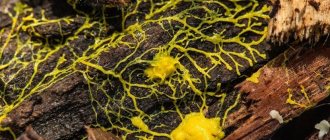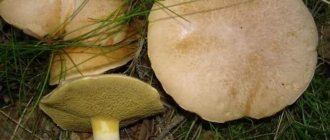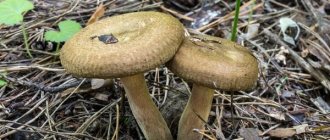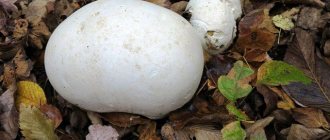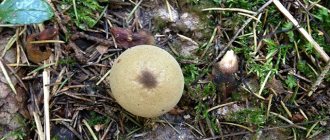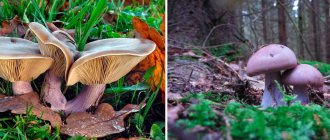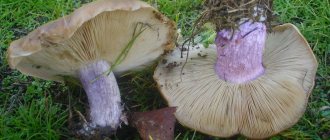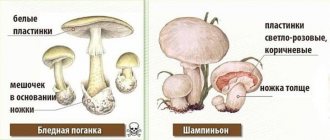The edible mushroom has an interesting appearance. Garlic has a number of healing properties, is widely used in medicine and is used in the creation of medicines.
In the article we will describe the appearance of a representative of a huge kingdom, analyze its structure and useful properties. The article will tell you about similar popular species, their features and differences, as well as their distribution area.
This is an edible specimen that requires preliminary short boiling before consumption. The species can be used as a seasoning or food additive. In this case, it must be crushed in advance and dried thoroughly. Experts classify the individual in the fourth category of edibility.
Culinary properties of pepper butter
Pepper mushroom is used as a seasoning in many countries around the world.
Renowned Italian chef Antonio Carluccio recommends using it not on its own, but in combination with other mushrooms, adding both a mushroom and a peppery component. It should be remembered that during the cooking process the peppery taste is gradually lost, and with prolonged heat treatment it disappears completely. If you do not use fresh mushrooms, but dry powder, then the peppery taste is lost very quickly, after just a few minutes, so it is better to sprinkle the powder directly onto the finished hot dish or into a ready-made sauce or gravy. In my experience, pepper mushroom is an excellent seasoning for a wide variety of dishes, including meat. I would recommend using it in dried form. Just half a pinch of dried mushroom (you need to chop the dried mushroom right before cooking, since whole dried mushrooms last much longer than the powder) will give stewed meat or beef steak the aroma of porcini mushrooms and spicy pepper at the same time. Pepper mushroom goes well with many other dishes, such as regular fried potatoes.
If the mushrooms are fresh, then you need to add them either very little, or, to reduce the pepperiness, pre-boil them and only then cook them along with the dish. I know of cases where boiled and then heavily fried pepper mushrooms were used as a spicy snack for vodka. I checked it (adding a little brown sugar at the end of cooking, for piquancy) - delicious.
Pepper mushrooms and violin have similar properties; they can also be used as a spicy mushroom seasoning.
Proper cleaning
To prevent fresh rotting leaves from darkening, it is advisable to clean them immediately. First you need to sort out the mushrooms and throw away any rotten or moldy ones. Before cooking, be sure to wash the mushrooms completely, remove debris and bugs from under the cap.
The product should not be washed if you plan to dry it. Then remove the pests with a knife. Preparation for drying involves only cutting off the moldy parts.
Cleaning is carried out differently if you need to pickle or pickle meadow mushrooms. They are pre-soaked in warm water for 20-30 minutes.
Then the film is carefully cut off so that the cap remains intact. To separate the delicate film, you can place the fungus under running water
All that remains is to rinse the purified product.
Where and how does it grow
The rotting bug can be found in coniferous or deciduous forests. It is widespread throughout the Northern Hemisphere. The favorite basis for its growth is at the base of trees: moss, small litter, foliage, bark. It can also grow on mossy trunks or stumps of birch trees.
The crop bears fruit for a long time - from July to October. Sometimes its representatives are called all-season, since they can be found in winter, during the thaw period, in forest thawed areas. The best time to collect is after rain, since the mushrooms are saturated with moisture, become clearly visible to the eye and at the same time emit a characteristic smell, by which they are easy to find.
Negniuchnik stamen-shaped
Family: Rowers (Tricholomataceae).
Synonyms: stamened rotten, bristle-footed non-rotted.
Description
The cap is 0.2-0.8 cm in diameter, very thin, convex, with a curled edge, then spread out, sometimes depressed in the middle and with a tubercle, radially wavy, folded, with a drooping or straight uneven edge, cream, light-colored , yellowish or brick-brown, darker in the middle. The plates are sparse, wide, thick, adherent, brownish, single-colored with a cap. The pulp is thin, light, odorless; the leg is hard, horn-shaped. Leg 2-5 X 0.1 cm, thread-like, hard, shiny, dark or black-brown, sometimes with a red tint. Dense mycelial strands extend from the base of the stalk, entwining any substrate and providing the fruiting body with strong fixation.
Staminate-shaped non-rotting fungi grow from early June to October in coniferous forests, on litter, needles, branches, cones, and are found frequently, annually, throughout the forest zone of Russia.
Similar species
The somewhat similar rotula (M. rotula) is distinguished by its significantly larger size and a very characteristic umbrella-shaped cap, as well as plates that grow not to the stem, but to the collarium ring located around it.
Medicinal properties
Medicines used for fractures, neuralgia, inflammation of the sciatic nerve, and migraines have been obtained from cultural mycelium. Experiments on mice have shown an immunostimulating effect.
The mushroom is characterized by a high content of polysaccharides.
Use in folk medicine
In Chinese medicine, in dried form or in the form of an extract, the plant is used as an analgesic, improves blood circulation, tonic and anti-gerontological agent. Medicines are made from rhizomorphs of the fungus grown in industrial conditions.
Is it possible to grow garlic mushroom on the plot?
It is not difficult to grow garlic mushrooms in your garden plot. They thrive in shady places in the garden. The optimal temperature for development is 15-20⁰С. To get mushrooms you need:
- Prepare willow or poplar logs 0.5 m long and up to 50 cm in diameter.
- Soak them for several days in water.
- Leave the wood in the sun for two days.
- Drill holes in the logs of a size corresponding to the purchased sticks with mycelium, at a distance of 10 cm from each other.
- Insert the sticks there.
- Wrap the logs in plastic wrap, leaving holes for ventilation.
- Place the logs in a dark place.
- After 4 months, the mycelium grows and the wood is transferred to the garden.
- Then set it vertically and dig in a little.
At a temperature of about 20 o C and constant humidity, mushrooms grow and produce a harvest of up to 15% of the wood mass.
It is possible to grow garlic using mycelium brought from the forest and scattered over the garden soil.
Gymnopus androsaceus
Current title
| Index Fungorum | Gymnopus androsaceus (L.) Della Maggiora & Trassinelli |
| MycoBank | Gymnopus androsaceus (L.) Della Maggiora & Trassinelli |
Systematic position
Etymology of the specific epithet
Androsaceus, a, um mik. stamen-like. From ανήρ, ανδρός ο husband, man, courageous person + σάκος, εος ο shield (large) + -eus, a, um quality. Also σάκκος ο bag, pouch.
Synonyms
- Agaricus androsaceus L., Sp. pl. 2: 1175 (1753)
- Merulius androsaceus (L.) With., Arr. Brit. pl., Edn 3 (London) 4: 148 (1796)
- Marasmius androsaceus (L.) Fr., Epicr. syst. mycol. (Upsaliae): 385 (1838)
- Chamaeceras androsaceus (L.) Kuntze, Revis. gen. pl. (Leipzig) 3(2): 478 (1898)
- Androsaceus androsaceus (L.) Rea, Brit. basidiomyc. (Cambridge): 531 (1922)
- Setulipes androsaceus (L.) Antonin, Česká Mykol. 41(2): 86 (1987)
- Gymnopus androsaceus (L.) J. L. Mata & R. H. Petersen, in Mata, Hughes & Petersen, Mycoscience 45(3): 220 (2004)
Habit
Fruiting body: Cap and stalk (agaricoid)
Hymenophore: Lamellar (including folded or with vestigial plates)
hat
The cap is 1.5 - 15 mm in diameter, at first hemispherical with a slightly depressed center, then spread out, folded-striped towards the edge, whitish, brown-pinkish, red-brown, yellow-brown.
The plates are adherent, sometimes fused at the stem into a pseudocollarium, the same color as the cap.
Leg
The leg is 24 – 60 mm long, 0.2 – 1 mm in diameter, thread-like, black, smooth, shiny.
Pulp
The pulp is thin, the smell and taste are unclear.
Microscopy
Spores (6.0) 7.0 – 9.0 (10) × (2.5) 3.5 – 4.5 (5.0) µm, Q = 1.9, broadly ellipsoidal, teardrop-shaped or almond-shaped.
Basidia 18 – 38 × 6.0 – 10 µm, club-shaped, 4-sometimes 2-spore.
Basidioles (14) 24 – 33 × 4.0 – 9.0 µm, fusiform, cylindrical or narrowly club-shaped.
Cheilocystids 12 – 50 (65) × 4.0 – 30 µm, unevenly club-shaped or bifurcated, branched in the upper part in the form of a panicle.
Pleurocystids are absent.
Buckles are present in all fabrics.
Ecology and distribution
- Substrate: Soil, litter
- Substrate: Herbaceous plants (live plants, herbaceous plant residues)
It grows in groups on dried leaves, needles, and small twigs. Recorded on litter and remains of shrubs: heather (Calluna), crowberry (Empetrum) and herbaceous plants: cotton grass (Eriophorum), northern linnaea (Linnaea borealis). Sometimes it grows from living plants, entangling them with black rhizomorphs.
Fruiting
The divisions correspond to the ten days of the month.
Nutritional properties
Similar species
- Micromphale perforans
- Marasmius rotula
Distribution throughout Western Siberia
Tomsk region: Bakcharsky and Shegarsky districts, coniferous forests, swamp, cedar needles, spruce, pine, fir (Perova N.V., Gorbunova N.A.).
Novosibirsk region: Toguchinsky district, env. village Peaceful, blueberry pine forest, on pine litter (Perova N.V., Gorbunova N.A.); env. village Kotorovo, fir, mixed forest, on rotting branches and fir needles, on the litter (Perova N.V., Gorbunova N.A.); Env. Novosibirsk Academic Town (Bulyonkova T. M.).
Kemerovo region: Novokuznetsk district, env. village Kuzedeevo, forb-snowy linden, forb-snowy aspen forest, on branches of linden and aspen (Perova N.V., Gorbunova N.A.).
Great garlic (Mycetinis alliaceus) what mushrooms look like, where and how they grow, edible or not
Great garlic: photo and description
| Name: | Great garlic |
| Latin name: | Mycetinis alliaceus |
| View: | Edible |
| Synonyms: | Greater rotten grass, Agaricus alliaceus, Chamaeceras alliaceus, Mycena alliacea, Agaricus dolinensis, Marasmius alliaceus, Marasmius schoenopus |
| Taxonomy: |
|
Greater garlic (the second name is Greater Garlic) belongs to the genus Garlic and is considered a variation of the fungi of the family of Greater Garlic. Rarely seen. Most avid mushroom pickers unfairly bypass it, believing that it is inedible.
This species is used for preparing culinary dishes, and when dried it serves as an aromatic seasoning that enhances the taste of various products.
What does a large garlic plant look like?
Greater garlic (Mycetinis alliaceus) is an all-season species, which is one of the first to appear, starting to bear fruit in the spring. It is found in forests, fields, on compacted grass and the first thawed patches.
This lamellar mushroom has a garlicky aroma, which is why it was named. Grows in large groups.
Description of the cap
The diameter of the hat is 1 – 6.5 cm. It has an ideal surface and is translucent along the edges. The shape of the cap of young specimens is bell-shaped and becomes prostrate as they grow.
The plates are permanent, not fused with the surface of the stem. The color of the caps can vary from red-brown to dark yellow. In the very center of the cap the color is more intense.
The coloring of the plates is grayish or pink-white. The fragile pulp has a garlicky odor when crushed. The surface of the cap is dry.
Description of the leg
The leg is elastic, smooth, with slight pubescence at the very base. The length of the leg can reach 6-15 cm, and the diameter is only 3 mm. The coloring is dark, often from brown to black with a specific shine.
The leg is cylindrical, sometimes flattened. The structure is dense. The color of the flesh of both the stem and the cap is similar.
Let's eat the mushroom or not
Garlic mushroom is an edible mushroom. It is consumed boiled and fried, boiled in advance for a short time. When boiled for a long time, the smell is lost. Fried with potatoes and used to make sauces. The taste, in which the mushroom flavor is complemented by a pronounced garlic flavor, is well appreciated.
In the Western European kitchen, large garlic is a real delicacy. It is prepared for future use by drying. Dried mushrooms retain their properties for 5 years. Before use, it is enough to hold the rotting agent in water for 5 - 10 minutes.
Dried garlic powder is used to prepare sauces and as an aromatic seasoning in a wide variety of dishes. It is also considered a very good natural preservative, increasing the shelf life of products.
Raw materials are not subject to rotting and do not become unusable if properly dried and stored. Negnyuchnik has antiviral, antifungal and antibacterial effects. Used in pharmacology for the production of medications.
Where and how does it grow
The fungus grows in colonies and is common in deciduous forests and fields in European territory. Prefers rotten branches, dead wood, stumps, and compacted grasses. The species is thermophilic, so it is less common in the northern and central regions. It occurs more often in the southern part of Russia.
Doubles and their differences
Great garlic can be confused with species of this family:
- Common garlic is an edible mushroom. It stands out for its small size and red-brown leg with a smooth surface.
- Oak garlic is a rare species, conditionally edible. It is distinguished by the structure of the cap, the color of the stem and its structure (in oak garlic it is pubescent). As it grows, it colors the substrate around itself white-yellow. Grows in oak plantings, on oak foliage.
Conclusion
Great garlic is a real delicacy from which you can prepare culinary masterpieces. In addition, the mushroom has useful elements and helps to extend the shelf life of products. Caps are used in cooking because the legs of the rotten mushroom have an elastic consistency. After cooking they become excessively tough.
Bioeffects
Scientists around the world are now studying radiobiological effects, that is, those changes that develop in the body as a result of exposure to radiation.
Let's say, for example, that you are now young and healthy. But if you are regularly irradiated, an accumulation effect will appear in the body. And then after some time, after 5-10-15 years, you will react much more pronounced to the same levels of exposure. Most likely, some of the people will be able to adapt, but some, unfortunately, will no longer be able to adapt. It's like smoking. For some, the effect may appear fairly quickly, while for others it may take a long time.
Electromagnetic sensitivity
Electromagnetic sensitivity depends on the individual resistance of the body to EMF. Currently, the world is divided roughly as follows:
- — 15% of particularly resistant people simply do not notice EMR.
- — In 70%, compensatory mechanisms are activated. This means that negative consequences appear only after some time.
- — And 15% of users are hypersensitive to EMR. Even after talking on a mobile phone once, they show symptoms.
The symptoms of electromagnetic sensitivity are quite serious. These include headaches and sleep problems. Problems with concentration and memory. Sometimes nosebleeds and severe thirst occur. A reaction resembling an allergic one develops, and unexplained skin rashes appear. As well as digestive problems, including abdominal pain, constipation, diarrhea. Neurological problems, palpitations, fatigue and loss of appetite. Increased fatigue and anxiety. For example, in 2004 in tiny Switzerland there were about 5% of such people.
Sleep problems
Typically, sleep problems occur when there is damage to the pineal gland, adrenal glands and thyroid gland. And it’s all due to radiation from the phone.
Research has shown that low levels of microwave exposure can reduce melatonin levels. Melatonin is not only important for maintaining sleep rhythm, but is also an antioxidant. After all, it helps repair damaged DNA and reduces the growth of cancer cells.
Additionally, research shows that thyroid hormone levels can be affected by wireless radiation. Thus, it was found that even a small change in thyroid hormones can affect the brain. And as a result, it can cause sleep problems in both adults and children.
Similar varieties
The common garlic mushroom has varieties similar in description:
- The garlic is large: it differs from the ordinary one in its large size (the cap reaches 5 cm in diameter), a black mushroom stem covered with “hair”, as well as plates with uneven edges. It is found in Europe among deciduous forests on fallen branches and foliage of beech trees.
- Oak garlic: this mushroom is a rare species. Most often it settles on fallen oak leaves. The variety is distinguished by a stalk covered with red-brown hairs and an excessively hygrophanic mushroom cap, the plates of which become very translucent in damp weather. The nearby substrate can give this species a white-yellow color and a specific garlic smell.
The garlic mushroom also has similar external characteristics to meadow honey mushrooms, since it is found in similar growing areas and is also colored in shades of brown. The latter have no garlic smell.
Irina Selyutina (Biologist):
The song that mushroom pickers came up with says that “the edible honey mushroom has a film ring on its leg.” This is partly true. But it has nothing to do with non-rot mushrooms (common, large, oak), which some novice mushroom pickers may confuse with meadow mushrooms. It’s good that non-rotting mushrooms (garlic mushrooms) belong to the edible species. But you still need to distinguish them:
- Garlics appear in late summer and autumn on dry litter in forests of various types.
- The caps are small in size (maximum 5 cm in diameter).
- The color of the caps varies from almost white to brownish.
- In adult specimens, the caps are almost always very spread out and slightly turned out.
- The legs are very thin, dark colored, hard.
- The legs lack the characteristic scales and “skirts” of honey mushrooms.
- The plates of the hymenophore are wavy, sparsely spaced, usually white or cream in color.
When collecting mushrooms, it is important to take into account all the signs together, otherwise the toadstool may end up in the basket.
Meadow honey mushrooms
Other names: non-rot mushroom, meadow mushroom, clove mushroom. These mushrooms have special properties: after a long drought, they are saturated with moisture and bear fruit again. They are undemanding to the substrate, so they are found in all fields. Description:
- Cap: reddish-yellow in color with a convex top, the edges are uneven, often cracking.
- Hymenophore: plates are infrequent, large, free in old mushrooms. Their color is slightly paler than the cap.
- Leg: long, thin, with a powdery coating. May taper downward.
- Pulp: white-yellow, has the smell of cloves or almonds.
The fruiting season is from May to October. In cooking, only caps are usually used, because... the legs are particularly rigid.
This species of honey mushroom is characterized by the following poisonous counterparts:
- whitish talker;
- wood-loving collibia.
What does garlic mushroom look like?
As you can see in the photo, the common garlic mushroom, or common garlic mushroom, is a very small lamellar mushroom on a thin stalk.
The mushroom is easily confused with toadstool. It has a small cap, the color of which gradually changes from shades of ocher to dark brown. His leg is thin and long. A distinctive feature is the strong garlicky smell of the mushroom, which persists even after drying.
Description of the cap
The garlic mushroom has a convex cap, the average size of which is 2 cm in diameter. Over time, it evens out and becomes more prostrate. At the beginning it is yellowish, with age the surface gradually darkens and becomes fawn. The miniature cap of the common garlic clove is dry in consistency, thin, with rough skin and grooves along the edges. In adulthood, it takes on a bell shape with thin brims and a depression in the center.
The plates have different lengths, wavy and convex shapes. Their color is white or pink. Spore powder is whitish.
Description of the leg
The structure of the garlic stalk is hollow. Its length, depending on age and place of growth, ranges from 0.5 cm to 5 cm, thickness - about 2 mm. Judging by the photo of the garlic mushroom, the surface of the stem is bare, pubescent at the bottom, and has small longitudinal grooves. The reddish color at the base becomes somewhat lighter.
The flesh of the leg is pale, with a garlicky odor, which becomes stronger after drying.
Dangerous doubles, the difference between edible and false
But do not confuse meadow mushrooms with:
- wood-loving collibia;
- Collibia oily;
- whitish talker;
- fiber.
The first twin mushroom also belongs to the Negniuchnikovs. Wood-loving collibia is popularly called spring or forest honey agaric, because it looks like its harmless counterpart. If you accidentally confuse these two mushrooms, nothing bad will happen. The double is conditionally edible, that is, it can be eaten after cooking. However, it has little value: the cap is small, taste and aroma are absent.
The oleaginous (oil-loving) collibia is similar to the wood-loving one, but its cap circumference is larger. It has no smell or taste.
Both collibia can be distinguished by the bulge in the middle. In twins it is absent or sticks out slightly. The plates of false mushrooms are frequent, while those of old ones have reddish inclusions. They can also be distinguished by their smell. In collibia, it is absent or gives off a damp soil with an admixture of mustiness. The meadow mushroom has a pronounced aroma of spice.
Among the talkers there are false, conditionally edible and edible varieties. There are about 250 species in total. Poisonous varieties pose a serious danger if eaten instead of an edible mushroom. Symptoms of intoxication appear after 30-40 minutes. Expressed by confusion of thoughts, faintness, pain in the abdominal area.
Even edible varieties of talkers can be dangerous if mixed with alcoholic beverages. They contain a substance that, when mixed with alcohol, causes increased sweating, tachycardia, hyperemia, and weakness. In case of severe poisoning, fainting or even death is possible.
Meadow mushrooms are usually confused with whitish talkers by inexperienced mushroom pickers. Because the double grows next to the non-rotting ones. However, distinguishing one mushroom from another is quite simple: the false one has a white cap, its edges are smooth and tucked inward.
Honey mushrooms are less often confused with fiber because they are visually different. The double's plate is gray and turns brown over time. All its varieties are poisonous (more than 100). Intoxication occurs quickly and affects the central nervous system.
Differences between false mushrooms and honey mushrooms:
- more elongated leg;
- repulsive odor;
- wrong shade of caps;
- greyish, brownish or greenish plates.
Common garlic - a mushroom with a garlicky odor
Common garlic is a mushroom of the Negniumaceae family, genus Garlic. This is an edible mushroom. It is also called the common rotting bug.
The Latin name of the mushroom is Marasmius scorodonius.
Description of common garlic
The cap of the garlic plant is of an ordinary convex shape; over time it becomes flat and outstretched. Its diameter is small - from 1 to 3 centimeters. The color of the cap is yellow-brown, slightly buffy, and eventually becomes fawn. It is lighter at the edges. The cap is small and dry, the skin is dense and rough.
There are small grooves along the edges of the cap. Fully ripe garlic caps become bell-shaped with very thin edges. Over time, the cap becomes wider, and a small depression appears in the central part. When it rains, the cap absorbs moisture and becomes a meat-red color, and in dry weather its color fades.
The flesh is pale with a pronounced smell of garlic, which becomes even stronger when dried, which is where the name of the mushroom comes from. The plates are wavy, convex, of different lengths, located far from each other. They grow to the base of the leg. Their color is whitish or pale red. White spore powder.
The leg is reddish-brown in color, with its lower part being lighter. The surface of the leg is shiny and cartilaginous. It's hollow inside.
Distribution of common spadefoot spade
These mushrooms are found in different types of forests. They grow in the forest floor, choosing dry places. Common garlic mushrooms prefer clay and sandy soils. Most often they are found in large groups. They bear fruit from July to October.
Mushroom colonies can be easily found by the smell of garlic that the mushroom bodies emit. On cloudy and rainy days, this smell becomes stronger.
Edibility of common garlic
These are edible mushrooms. They can be consumed boiled, fried, pickled and dried. Also, common garlic cloves are well suited for preparing hot spices. After boiling, the characteristic garlic smell disappears, but when dried, on the contrary, it intensifies.
Similarities between common garlic and other mushrooms
The common garlic can be confused with the meadow honey fungus, which grows on branches and fallen needles, but does not have the smell of garlic.
Other mushrooms of this genus
Blood-headed rotten mushroom is one of the rarest mushrooms in the world. Its peculiarity is that it glows in the dark. There is very little information available about these mushrooms.
The blood-headed gnats have a graceful appearance - their legs are very thin, and their dome-shaped caps are deep red in color. The caps have longitudinal stripes on top, located symmetrically in relation to each other. The leg is darker. These mushrooms grow on fallen or old trees. There is no information about their toxicity, but they are classified as inedible species.
The rotten stamen is an inedible mushroom. His cap is initially convex, but with age it becomes prostrate.
The staminate plant bears fruit from June to September. These mushrooms settle on small branches of fallen trees. They are often found among sand dunes and wastelands.
They grow in large colonies, which consist of several dozen specimens.
There is no information about the toxicity of these mushrooms; it is possible that they do not contain toxic substances, but they are classified as inedible species and are not eaten because of the unpleasant odor of the pulp.
Spreading
The garlic mushroom can be found in coniferous and deciduous forests. The specimen prefers relatively dry places, clay and sandy soils.
The Northern Hemisphere and some regions of Russia are the main places of concentration of the species. It grows in large groups, but can be found individually less often. One colony can contain dozens of individuals. Fallen needles, tree trunk areas, branches, rotting bark, heather stems, fields and grass vegetation are home to garlic.
PEPPER MUSHROOM (PEPPER CUP)
Pepper mushroom (Chalciporus piperatus), or, as it is also called, pepper butterfly, is characterized by a strong peppery (burning) taste of the pulp. Like the well-known bitter twin of the porcini mushroom (Tylopilus felleus), it is considered inedible, and completely in vain. It’s surprising that this is practically the only case known to me when domestic sources define a mushroom as inedible, and European sources as edible and even tasty.
Pepper butterdish grows everywhere where there are its partner trees (i.e., not only in forests, but also in parks, gardens and even garden plots), but either singly or in small groups of several fruiting bodies. Therefore, collecting it in large quantities is a rather difficult, if not impossible, task. In general, the fungus is widely represented throughout the northern hemisphere, and in recent decades, along with pine seedlings, it has penetrated into South America and Australia and New Zealand.
The fruiting bodies of the pepper mushroom are often affected by fungal mold, the marsupial mycoparasite Sepedonium chalcipori, covering the mushrooms with a solid, dense white-yellow coating. Initially, the pepper mushroom was considered a purely mycorrhizal fungus. Meanwhile, multifaceted studies conducted over the past 20 years (attempts to track mycorrhiza in the soil, to obtain artificial mycorrhiza in vitro, to obtain mycorrhiza in vivo, isotopic analysis of mycelial threads and roots, i.e., analysis of the movement of labeled atoms) did not reveal the presence of mycorrhiza and in general any contact between the fungus and the tree
Then mycologists drew attention to the fact that pepper mushrooms are constant companions of the red fly agaric and yellow chanterelle. It was suggested that the pepper butterfly is not a tree symbiont, but a parasite of the mycorrhizal red fly agaric and, possibly, the chanterelle, and parasitizes not on fruiting bodies (like its relative the parasitic fly agaric, which infects false puffballs), but on the mycelium, and not in any place, namely in its mycorrhizal areas
This fact is considered as one of the confirming points. Along with seedlings of radiata pine (Pinus radiata), the red fly agaric penetrated into Australia and New Zealand. A few years later, he found a new local partner - deciduous trees of the Southern Beech (Nothofagus) genus. So, after a few more years, pepper mushrooms appeared under the southern beeches, although before that they were seen all over the world only under conifers. These are very recent studies from 2010–2012. It is also known that the closest relative of the pepper fungus, Buchwaldoboletus lignicola, also grows under coniferous trees and only next to the Schweinitz polypore (Phaeolus schweinitzii), of which it is assumed to be a parasite. It is possible that all species of the genus Chalciporus, as well as its relatives, are mycoparasites.
Of the mushrooms that are closely related in appearance, the pepper butterfly is quite similar to the goat. However, the difference in taste will immediately tell you who is who.
Interestingly, in Europe, designers use the fruiting bodies of the pepper mushroom to obtain natural dyes. Depending on the etching, a yellow, orange or greenish-brown color is obtained.
Mycological characteristics
These parameters of a mushroom variety include edibility and propagation options. The mushroom culture grows in natural conditions and can be grown artificially in the garden.
Edibility
The mushroom is considered edible; after processing, the fruits are consumed boiled, fried, dried or pickled. Dry mushrooms are used instead of hot spicy spices because of their characteristic rich garlic taste and aroma. Please note that after boiling the aroma disappears. In dried mushrooms, the smell becomes rich, spicy-sweet.
Reproduction
Occurs with the help of spores. The spore print of the fungal culture is white. The spores are elliptical in shape and develop in the spore layer. They spread in natural conditions by gusts of wind, rainwater, and insects. Garlic can be propagated by parts of the mycelium or fruit. These methods are used by mushroom pickers for artificial propagation of crops.
the mushroom has a rich chemical composition and has a positive effect on human health
Common garlic mushroom (garlic mushroom): photo and description
| Name: | Common garlic |
| Latin name: | Mycetinis scorodonius |
| Type: | Edible |
| Synonyms: | Common rotting moth Marasmius scorodonius |
| Characteristics: |
|
| Taxonomy: |
|
In addition to the well-known mushrooms, which are the basis of many dishes, pickles and marinations, there are species that can easily be used as a seasoning for them. The garlic mushroom can play this role. It has a smell that is very suitable for the hot and spicy forge. If you pinch off a piece of the cap and rub it between your fingers, you can smell the distinct smell of garlic.
How can I help my baby?
At the very beginning of the development of symptoms similar to the first signs of laryngeal edema - mild cough, rapid breathing - preventive measures must be taken.
- The very first thing: ventilate the children's room and humidify the air. Then it will become easier for the child to breathe: in a dry and stuffy room, swelling of the larynx increases. If there is no humidifier in the house, hang wet towels on the radiators and change them as they dry.
- When an attack begins, you must immediately call an ambulance! And remain calm: if adults show how scared they are and begin to panic, the child’s condition worsens.
- While help is still on the way, we are taking measures to help the child. First, take him in your arms vertically, this makes it easier to breathe, speak in an even voice, calmly stroking his back.
- The best thing is if there is an inhaler or nebulizer in the house. It is optimal to use alkaline mineral water or baking soda solution (1/4 teaspoon per glass of water).
Common garlic
Common garlic (lat. Mycétinis scorodónius) is a species of mushroom belonging to the genus Mycetinis of the Marasmiaceae family. A small mushroom with a strong garlic odor, used as a seasoning.
Other name: Common rotting plant
Hat:
convex cap, with a diameter of one to three centimeters. Then the cap becomes flat and spread. The surface of the cap is yellow-brown, slightly ocher, later fawn. The hat is miniature and dry. The thickness of the cap is a quarter of a match. The edges of the cap are lighter, the skin is rough and dense. The surface of the cap has small grooves along the edges. A fully mature specimen is characterized by very thin brims and a bell-shaped cap. The cap expands over time and a small depression forms in the central part. In rainy weather, the cap absorbs moisture and acquires a meat-red color. In dry weather, the color of the cap becomes dull.
Records:
wavy plates, located at a distance from each other, of different lengths, convex. Legs fused to the base. Whitish or pale reddish in color. Spore powder: white.
Leg:
reddish-brown leg, in the upper part it has a lighter shade. The surface of the leg is cartilaginous and shiny. The leg is hollow inside.
Spreading:
Common garlic is found in forests of various types. Grows in dry places on the forest floor. Prefers sandy and clay soils. Typically found in large groups. The fruiting period is from July to October. Garlic owes its name to its strong garlicky smell, which intensifies on cloudy, rainy days. Therefore, this characteristic feature makes it easier to find colonies of this fungus.
Similarity:
Common garlic has some similarities to Opy Lugovoi, growing on fallen needles and branches, but they do not have a garlicky smell. It can also be mistaken for the larger Garlic, which also smells like garlic, but it grows on beech stumps and is not as tasty.
Edibility:
Common garlic is an edible mushroom, consumed fried, boiled, dried and pickled. Used to prepare hot spices. The characteristic smell of the mushroom disappears after boiling and intensifies when dried.
Definitioner
Basidia (Basidia)
Lat. Basidia. A specialized structure of sexual reproduction in fungi, unique to basidiomycetes. Basidia are terminal (end) elements of hyphae of various shapes and sizes, on which spores develop exogenously (outside).
Basidia vary in structure and method of attachment to hyphae.
Based on the position relative to the axis of the hyphae to which they are attached, three types of basidia are distinguished:
Apical basidia are formed from the terminal cell of the hypha and are located parallel to its axis.
Pleurobasidia are formed from lateral processes and are located perpendicular to the axis of the hypha, which continues to grow and can form new processes with basidia.
Subbasidia are formed from a lateral process turned perpendicular to the hyphal axis, which stops growing after the formation of one basidium.
Based on morphology:
Holobasidia are single-celled basidia, not divided by septa (see Fig. A, D).
Phragmobasidia are divided by transverse or vertical septa, usually into four cells (see Fig. B, C).
By type of development:
The heterobasidium consists of two parts - the hypobasidium and the epibasidium developing from it, with septations (see Fig. C, B) or without them (see Fig. D).
Homobasidia is not divided into hypo- and epibasidia and in all cases is considered to be holobasidium (Fig. A).
The basidium is the site of karyogamy, meiosis, and the formation of basidiospores. Homobasidy, as a rule, is not functionally divided, and meiosis follows karyogamy. However, the basidia can be divided into probasidium, the site of karyogamy, and metabasidium, the site of meiosis. Probasidium is often a resting spore, for example in rust fungi. In such cases, the probasidium germinates into a metabasidium, in which meiosis occurs and on which basidiospores are formed (see Fig. E).
See Karyogamy, Meiosis, Hypha.
Pileipellis
Lat. Pileipellis, skin - a differentiated surface layer of the cap of agaricoid basidiomycetes. The structure of the skin in most cases differs from the inner flesh of the cap and may have a different structure. The structural features of pileipellis are often used as diagnostic characters in descriptions of fungal species.
Based on their structure, they are divided into four main types: cutis, trichoderma, hymeniderma and epithelium.
See Agaricoid fungi, Basidiomycete, Cutis, Trichoderma, Hymeniderma, Epithelium.
COMMON GARLIC
Many people have heard about this fungus, but not everyone knows and collects it. But in vain, because mushrooms that combine the properties of a mushroom and an excellent seasoning do not often grow in our forests. The common garlic (Mycetinis scorodonius), which grows almost everywhere, has no less delicious southern garlic-smelling relatives - the oak garlic (Marasmius prasiosmus) and the great garlic (Marasmius alliaceus). Both mushrooms are quite thermophilic and are found very rarely in the conditions of central Russia. Dried garlic, like all other non-rotting herbs, have the property, when moistened, to become fresh again without losing their taste.
Garlic plants are easy to grow in your garden. They feel best in shady places under trees, bushes, grass, raspberries, etc. at a temperature of 15–30 ° C in spring, summer, and autumn. It bears fruit 4 weeks after planting the mycelium or the next year after the mycelium is transferred from the forest, the harvest comes in waves, approximately every 3 weeks. For best results, you need to “fluff” a plot of land of about 2.5 m2, scatter the mycelium evenly or distribute forest mycelium, sprinkle a layer of garden soil (5–10 cm) on top and water. In the future, moisturize as needed.
Garlic is clearly distinguishable from any other small fungus by the combination of a hard, shiny red-brown stem and a strong smell of garlic, which intensifies when the cap is rubbed.
This fungus is a valuable raw material for obtaining preventive and antiviral and bactericidal drugs. The mushroom does not rot, helps preserve food components and increases its shelf life. Contains antibiotic substances that are active against staphylococcal infections. It is not difficult to find, despite its small size. Under favorable conditions, the mushroom grows in large rashes, several dozen or even hundreds of fruiting bodies. Often it produces a friendly harvest on some pine or spruce branch that you like, although single fungi or groups of 2-5 fruiting bodies are also not uncommon. If the weather is dry and windless, then garlic mushrooms are sometimes easier to find by smell than visually. The aroma of the fungi is volatile, but quite heavy, and hangs over the colony as a dense fragrant cloud, slowly drifting to the side in the event of a light breeze. In the late autumn forest, when the colorful litter and water reflections on wet leaves and branches hide all the mushroom detail, I look for garlic mushrooms in this way - by smell. It should be noted that not only the rotten mushrooms themselves smell of garlic, but also their mycelium. Many years ago, back in the last millennium, while walking through a young spruce forest in February, I smelled a pleasant and rather strong smell of garlic. At the same time, there was a thick and dense layer of snow lying around, and no lost bunches of garlic were observed. Logically deciding that only garlic mushrooms could smell this way, I looked around in search of these fungi. But I saw nothing but snow. And then, to emit such a strong smell, a solid colony of a hundred copies had to “work.” I started digging in the snow and lifting my lower paws from the surrounding spruce trees. A mysterious source of the smell was discovered under one of these nearby trees. The spruce was young, but with large and thick lower legs, just right for the New Year. Covered with snow, the furry paws sank to the ground, and under the trunk, as if under a green tent, there was a space not covered with snow. There, on a warm pillow of fallen pine needles, settled down... no, not a family of garlic moths, but their mycelium, which permeated almost all the needles in this peculiar February greenhouse. It was the mycelium that emitted such a familiar smell.
Practical use
Garlic species are among the edible mushrooms. They do not require heat treatment before being used in cooking. Suitable as a seasoning for marinades, sauces, main courses and soups. Used fresh, dried or fried.
Common garlic is a valuable raw material, on the basis of which preventive and medicinal products with a bactericidal and antiviral spectrum of action are obtained. The chemical composition of the fungus contains antibiotic substances that can even fight staphylococcal infections.
Since the mushroom does not rot, it helps preserve individual food components and even increases its shelf life.
